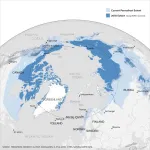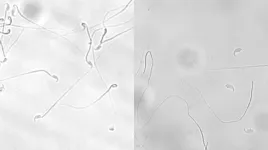(Press-News.org)
The mystery behind why Alaskan horses, cryptodiran turtles and island lizards shrunk over time may have been solved in a new study.
The new theoretical research proposes that animal size over time depends on two key ecological factors: the intensity of direct competition for resources between species, and the risk of extinction from the environment.
Using computer models simulating evolution, the study, published today (Thursday, 18 January) in communications biology, identifies why some species gradually get smaller, as indicated by fossil records.
Dr Shovonlal Roy, an ecosystem modeller from the University of Reading who led the research, said: "Just like how we try to adapt to hot or cold weather depending on where we live, our research shows animal size can get bigger or smaller over long periods depending on the habitat or environment.
"In places and times where there's lots of competition between different species for food and shelter, animal sizes often get smaller as the species spread out and adapt to the distribution of resources and competitors. For example, small horses that lived in Alaska during the Ice Age rapidly shrank due to changes in the climate and vegetation.
“Where direct competition is less, sizes tend to get bigger, even though being really big and few in number can make animals more vulnerable to dying out – such as what happened with the dinosaurs.
“Changes in ecological factors help explain why fossil records shows such confusing mixes of size evolution patterns, with some lineages shrinking over time and others growing."
Cope’s rule
The research team carried out their study by challenging the contradictions fossil evidence posed to “Cope’s rule.” Cope’s rule refers to the tendency for certain animal groups to evolve larger body sizes over thousands and millions of years. The rule is named after Edward Cope, a 19th-century palaeontologist who was credited to have first noticed this pattern in the fossil record. For example, early horse ancestors were small dog-sized animals that increased in size over evolutionary time, ultimately producing the modern horse.
However, fossil evidence shows remarkably conflicting trends, with increased size in some groups but decreased size in others.
Evolutionary pressure
Using computer models simulating evolution, the study identified three distinct patterns of body-size change emerging under different conditions:
Gradual size increase over time: This happens when competition between species is determined mostly by their relative body sizes rather than niche differences. For example, several genera of marine animal species (e.g. invertebrates) gradually increased in size over millions of years.
Size increase followed by extinctions: Here the largest animals recurrently go extinct, opening opportunities for other species to take their place and evolve even bigger bodies, continuing the cycle. Mass extinctions hit large-bodied apex predators hardest. Very large mammals and birds are particularly vulnerable to extinction – for example, dinosaurs and giant flying reptiles.
Gradual size decrease over time: The simulations also predicted the opposite of Cope’s rule: species shrinking over time. This happens when competition is high and there is a degree of overlap in habitat and resource use. As species evolve apart into distinct niches, they face evolutionary pressure to reduce in size. Decline in size was previously reported for vertebrates, bony fish, cryptodiran turtles, Alaskan Pleistocene horses, and island lizards
END
Researchers from The University of Texas MD Anderson Cancer Center reported promising results in a Phase I/II trial of 37 patients with relapsed or refractory B-cell malignancies who were treated with cord blood-derived chimeric antigen receptor (CAR) natural killer (NK) cell therapy targeting CD19.
Published today in Nature Medicine, the findings reveal an overall response (OR) rate of 48.6% at 100 days post treatment, with one-year progression-free survival (PFS) and overall survival (OS) rates of 32% & 68%, respectively. The trial reported an excellent safety profile with no cases of severe cytokine release syndrome (CRS), neurotoxicity, ...
· New finding to understand brain cell loss in neurodegenerative disease
· Increasing protective short RNAs may be new approach to halt or delay Alzheimer’s
· SuperAgers with superior memories have more protective short RNAs in their brains
CHICAGO --- Alzheimer’s disease, which is expected to have affected about 6.7 million patients in the U.S. in 2023, results in a substantial loss of brain cells. But the events that cause neuron death are poorly understood.
A new Northwestern Medicine study shows that RNA interference may play a key role in Alzheimer’s. For the first time, ...
The way science is funded is hampering Earth System Models and may be skewing important climate predictions, according to a new comment published in Nature Climate Change by Woodwell Climate Research Center and an international team of model experts.
Emissions from thawing permafrost, frozen ground in the North that contains twice as much carbon as the atmosphere does and is thawing due to human-caused climate warming, are one of the largest uncertainties in future climate projections. But accurate representation of permafrost dynamics is missing from ...
A team of researchers from China, Australia, France, Spain, and Germany has revealed advanced material culture in East Asia by 45,000 years ago.
The new study was published in Nature Ecology & Evolution on Jan. 18.
The researchers examined a previously excavated archaeological collection from the Shiyu site, located in Shanxi Province.
"Our new study identified an Initial Upper Palaeolithic archaeological assemblage from the Shiyu site of North China dating to 45,000 years ago that includes blade technology, tanged and hafted projectile points, long-distance obsidian transfer, and the use of a perforated ...
Throughout the brain’s cortex, neurons are arranged in six distinctive layers, which can be readily seen with a microscope. A team of MIT neuroscientists has now found that these layers also show distinct patterns of electrical activity, which are consistent over many brain regions and across several animal species, including humans.
The researchers found that in the topmost layers, neuron activity is dominated by rapid oscillations known as gamma waves. In the deeper layers, slower oscillations called alpha and beta waves ...
200 US communities will fail to transition to 100% renewable energy by 2050 despite their pledges to do so, according to a new study published in IOP Publishing’s journal Environmental Research: Infrastructure and Sustainability.
The study shows that by 2050 gas will firmly remain the primary source of energy in the US given that the current infrastructure plans for implementing renewable energy cannot provide sufficient energy output. Recent projections suggest that renewable energy generation will need to triple to meet even a 45% share of energy production. The results indicate that in many instances renewable energy ...
The European Society of Endocrinology (ESE) is pleased to announce that the new Editor-in-Chief of our flagship journal, the European Journal of Endocrinology (EJE), is Professor Felix Beuschlein, M.D. He will assume his post in May 2024 when the current Editor in Chief, Professor Wiebke Arlt, steps down.
Professor Philippe Chanson, Chair of ESE’s Publications and Communications Committee said, “I am delighted that Felix will be the next Editor in Chief of ESE’s flagship journal and will continue to build on the strong foundations laid by his predecessors. Felix’s internationally ...
Mice lacking a certain gene are unable to produce offspring because their sperm lack the connection between the tail and the head. A new thesis from the University of Gothenburg indicates a probable cause of male infertility.
Researchers at the University of Gothenburg have identified a new protein, dubbed by them as “MC2”, that plays a crucial part in the formation of swimmable sperm in mice. This protein is needed to create a functional connection between the head and the tail of the sperm.
“The connection is located in the ‘neck’ of the sperm head and facilitates coordinated movement and function ...
(WASHINGTON, DC) 18 JANUARY 2024 — Bottom trawling is a previously unaccounted for source of atmospheric carbon emissions, scientists reveal in a study published today. As the world scrambles to slash emissions caused by fossil fuels, deforestation and other sources, the study finds bottom trawling — the act of dragging a heavy fishing net across the ocean floor and resuspending some of the carbon in the seafloor sediment — to be a significant source of atmospheric carbon pollution. A previous study found that part of that disturbed ...
Osaka, Japan – At the heart of global internet connectivity, optical communications form an indispensable foundation. Key to this foundation are optical isolators, created by combining multiple components. The result is a complex structure that transmits light in only one direction, to prevent damage to lasers and minimize noise by avoiding the reversal of light. However, some magnetic materials have an optical diode effect – an unconventional nonreciprocal absorption of light manifested by the material itself. This effect leads to a change in transmittance depending ...





